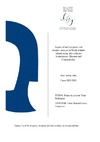Identificador persistente para citar o vincular este elemento:
https://accedacris.ulpgc.es/jspui/handle/10553/74531
| Campo DC | Valor | idioma |
|---|---|---|
| dc.contributor.advisor | Viera Rodríguez, María Ascensión | es |
| dc.contributor.advisor | Costa Gonçalves, Víctor Manuel | es |
| dc.contributor.author | Soroa Jorba, Axel | es |
| dc.date.accessioned | 2020-09-22T09:17:15Z | - |
| dc.date.available | 2020-09-22T09:17:15Z | - |
| dc.date.issued | 2020 | - |
| dc.identifier.uri | https://accedacris.ulpgc.es/handle/10553/74531 | - |
| dc.description.abstract | The oceanic islands are considered fragile ecosystems. These delicate places were controlled by climate changes in the past, however with the arrival of humans, the anthropogenic pressure in this kind of habitat became undeniable. So, to assess the human impact and climatic pressure, two bioindicators (Diatom and Chironomid) located in the lakes of the Azores Archipelago, Faroe Islands, Greenland and Iceland were used. Several corers (Russian type-corer and UWITEC gravity corer) were used to take sediment samples in the lakes and then using the right resources the identification of the different species of the bioindicators began. The chironomids result indicated the initial impact of humans was not very severe and the principal changes were attributed to climatic change. However some activities like fish introduction could greatly affect these organisms. The diatoms showed a domination of benthic species before the anthropogenic presence, but with the arrival of humans there was a shift to planktonic dominance in the lakes. Since the colonization of the islands, notable changes occurred in the landscapes, activities like deforestation or animal introduction led to a visible transformation in the surroundings of the lakes. However, some lakes did not show many changes during the initial presence of humans. These changes were more attributed to climatic consequences. The period of the MWP (Medieval Warm Period) and the LIA (Little Ice Age) for instance, greatly affected the ecosystems of these kinds of places and several changes were observed. So, the utilization of these bioindicators can be useful to observe the changes that were produced by the climate and furthermore, the anthropogenic impact. | en_US |
| dc.language | eng | en_US |
| dc.relation | DiscoverAZORES – “When were the Azores archipelago really colonized? A high-resolution paleolimnological approach”, (Fundação para a Ciência e a Tecnologia) (PTDC/CTA-AMB/28511/2017) | en_US |
| dc.subject | 250501-1 Biogeografía botánica | en_US |
| dc.subject | 251004 Botánica marina | en_US |
| dc.subject.other | Bioindicators | es |
| dc.subject.other | Diatoms | es |
| dc.subject.other | Chironomids | es |
| dc.title | Impact of anthropogenic and climatic stressors in North Atlantic islands using lake sediment bioindicators (Diatoms and Chironomids) | es |
| dc.type | info:eu-repo/semantics/bachelorThesis | en_US |
| dc.type | BachelorThesis | en_US |
| dc.contributor.departamento | Departamento de Biología | es |
| dc.contributor.facultad | Facultad de Ciencias del Mar | en_US |
| dc.investigacion | Ciencias | en_US |
| dc.type2 | Trabajo final de grado | en_US |
| dc.identifier.matricula | TFT-57205 | es |
| dc.identifier.ulpgc | Sí | es |
| dc.contributor.buulpgc | BU-BAS | es |
| dc.contributor.titulacion | Grado en Ciencias del Mar | es |
| item.grantfulltext | open | - |
| item.fulltext | Con texto completo | - |
| crisitem.advisor.dept | GIR ECOAQUA: Ecofisiología de Organismos Marinos | - |
| crisitem.advisor.dept | IU de Investigación en Acuicultura Sostenible y Ec | - |
| Colección: | Trabajo final de grado | |
Los elementos en ULPGC accedaCRIS están protegidos por derechos de autor con todos los derechos reservados, a menos que se indique lo contrario.
